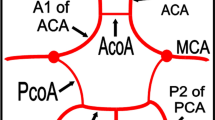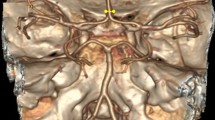Abstract
Purpose
The aim of our study is to examine the morphometry of the P1 segment of the posterior cerebral artery (P1) and the posterior communicating artery (PcomA) and to present a descriptive classification according to morphometric findings.
Methods
340 hemispheres from 170 cadavers were included. The outer diameters of P1 and PcomA were measured with ImageJ software. Then, the configurations of the posterior cerebral artery were revealed as fetal, adult and transitional. The findings were correlated with the demographic information of the cadavers such as gender, body mass index (BMI), age.
Results
According to the morphometric findings, 83.75%, 13.85% and 2.40% of the posterior cerebral arteries were found to be adult, fetal and transitional, respectively. The fetal type was more common in cadavers aged 60 years and older (13.73%) compared to the 18–39 and 40–59 age groups. In addition, P1 and PcomA diameters also increased with age. Fetal and transtional types showed a similar low distribution in people with low (< 18.5), normal (18.5–24.9), overweight (25–29.9) and obese (> 30) BMI, whereas adult type was found in cadavers with a normal BMI of 140/303.
Conclusion
We believe that the findings of our study will contribute to the planning of neurointerventional procedures, the development of endovascular devices, the success of invasive procedures and the reduction of complications.





Similar content being viewed by others
Data availability
Gkionoul.chatzioglou@istun.edu.tr.
Abbreviations
- PCA:
-
Posterior cerebral artery
- P1:
-
P1 segment of posterior cerebral artery
- PcomA:
-
Posterior communicanting artery
- pP1:
-
Proximal part of P1 segment of posterior cerebral artery
- dP1:
-
Distal part of P1 segment of posterior cerebral artery
- dPcomA:
-
Distal part of posterior communicanting artery
- LPCA:
-
Length of posterior cerebral artery
References
Arıncı K, Elhan A (2020) Anatomi, 2nd edn. Güneş Tıp Kitabevleri, Anakara
Bhanu SP, Pentyala S, Sankar DK (2020) Incidence of hypoplastic posterior communicating artery and fetal posterior cerebral artery in Andhra population of India: a retrospective 3-Tesla magnetic resonance angiographic study. Anat Cell Bio 53:272–278. https://doi.org/10.5115/acb.20.066
Coulier B (2021) Morphologic variants of the cerebral arterial circle on computed tomographic angiography (CTA): a large retrospective study. Surg Radiol Anat 43:417–426. https://doi.org/10.1007/s00276-020-02661-x
Davidoiu AM, Mincă DI, Rusu MC, Hostiuc S, Toader C (2023) The fetal type of posterior cerebral artery. Medicina 59:231. https://doi.org/10.3390/medicina59020231
De Silva KRD, Silva R, Gunasekera WL, Jayesekera RW (2009) Prevalence of typical circle of Willis and the variation in the anterior communicating artery: a study of a Sri Lankan population. Ann Indian Acad Neurol. https://doi.org/10.4103/0972-2327.56314
Diogo MC, Fragata I, Dias SP, Nunes J, Pamplona J, Reis J (2016) Low prevalence of fetal-type posterior cerebral artery in patients with basilar tip aneurysms. J NeuroInterv Surg 9:698–701. https://doi.org/10.1136/neurintsurg-2016-012503
Dodevski A, Lazarova DT, Mitreska N, Aliji V, Stojovska JE (2014) Posterior cerebral artery-variation in the origin and clinical significance. Prilozi (Makedon Akad Nauk Umet Oddel Med Nauki) 35(1):163–168
Enyedi M, Scheau C, Baz RO, Didilescu AC (2023) Circle of Willis: anatomical variations of configuration. a magnetic resonance angiography study. Folia Morphol 82:24–29. https://doi.org/10.5603/FM.a2021.0134
Frid P, Wasselius J, Drake M, Wu O, Petersson J, Rost NS, Lindgren A (2022) Fetal posterior cerebral artery configurations in an ischemic stroke versus an unselected hospital population. Acta Neurol Scand 145:297–304. https://doi.org/10.1111/ane.13558
Gaigalaite V, Dementaviciene J, Vilimas A, Kalibatiene D (2019) Association between the posterior part of the circle of willis and the vertebral artery hypoplasia. PLoS ONE 14:1–11. https://doi.org/10.1371/journal.pone.0213226
Goehre F, Jahromi BR, Hernesniemi J, Elsharkawy A, Kivisaari R, von und zu Fraunberg M, Jaaskelainen J, Lehto H, Lehecka M, (2014) Characteristics of posterior cerebral artery aneurysms: an angiographic analysis of 93 aneurysms in 81 patients. Neurosurgery 75:134–144. https://doi.org/10.1227/NEU.0000000000000363
Gunnal SA, Farooqui MS, Wabale RN (2015) Study of posterior cerebral artery in human cadaveric brain. Anat Res Inter. https://doi.org/10.1155/2015/681903
Karataş A, Yilmaz H, Çoban G, Koker M, Uz A (2016) The anatomy of circulus arteriosus cerebri (circle of Willis): a study in Turkish population. Turk Neurosurg 26:54–61. https://doi.org/10.5137/1019-5149.jtn.13281-14.1
Kardile PB, Ughade JM, Pandit SV, Ughade MN (2013) Anatomical variations of anterior communicating artery. J Clin Diagn Res. https://doi.org/10.7860/JCDR/2013/6664.3725
Kaya AH, Dağçinar A, Ulu MO, Topal A, Bayri Y, Ulus A, Kopuz C, Sam B (2010) The perforating branches of the P1 segment of the posterior cerebral artery. J Clin Neurosci 17:80–84. https://doi.org/10.1016/j.jocn.2009.03.046
Osborn AG (1999) Diagnostic cerebral angiography, 2nd edn. Lippincott Williams Wilkins, Philadelphia
Párraga RG, Ribas GC, Andrade SEGL, de Oliveira E (2011) Microsurgical anatomy of the posterior cerebral artery in three-dimensional images. World Neurosurg 75:233–257. https://doi.org/10.1016/j.wneu.2010.10.053
Prefulla PR, Mohanapriya E, Bose E, Keerthi S (2021) Study of variations of posterior communicating artery and types of posterior circulation in human cadaveric brains of south indian population. J Anat Soc India 70:221–225. https://doi.org/10.4103/jasi.jasi_215_20
Rai AT, Rodgers D, Williams EA, Hogg JP (2013) Dimensions of the posterior cerebral circulation: an analysis based on advanced non-invasive imaging. J NeuroIntervent Surg 5:597–600. https://doi.org/10.1136/neurintsurg-2012-010549
Rao MJ, Vinila BS, Yesender M (2017) Variations in the configuration of the posterior cerebral circulation in the adult human cadavers. Indian J Clin Anat Physiol. https://doi.org/10.18231/2394-2126.2017.0111
Rhoton AL Jr (2019) Rhoton’s cranial anatomy and surgical approaches. New York. LSC Communications, Oxford University Press
Saha A, Sarkar A, Mandal S (2015) A cadaveric study of bilateral configuration of posterior bifurcation of posterior communicating artery in Indian population. J Clin Diagn Res 9:1–4. https://doi.org/10.7860/JCDR/2015/11256.5650
Standring S (2016) Gray’s anatomy: the anatomical basis of clinical practice, 41st edn. Elsevier, Amsterdam
van Emden MW, Geurts JJ, Schober P, Schwarte LA (2018) Comparison of a novel cadaver model (fix for life) with the formalin-fixed cadaver and manikin model for suitability and realism in airway management training. Anesth Analg 127:914–919. https://doi.org/10.1213/ANE.0000000000003678
Vasović L, Trandafilović M, Jovanović I, Ugrenović S, Vlajković S, Stojanović J (2011) Types and subtypes of the posterior part of the cerebral arterial circle in human adult cadavers. In: Vieira DN (ed) Forensic Medicine - From Old Problems to New Challenges. InTech, London, pp 359–382
Veras TW, Elhert GW (2010) Variation of the posterior cerebral artery and its embryological explanation: a cadaveric study. Bol Asoci Medica Puerto Rico 102:55–58
Yașargil MG, (1984) Microneurosurgery I. microsurgical anatomy of the basal cisterns and vessels of the brain, diagnostic studies, general operative techniques and pathological considerations of the intracranial aneurysms. Thieme Stratton Inc, Stuttgart-New York
Funding
No funding received
Ethics declarations
Conflict of interest
The authors declare that they have no conflict of interest
Ethical approval
Ethics committee approval of our study was received by the Istanbul Medical Faculty Clinical Research Ethics Committee (date: 17.02.2023, number: 2023/320)
Additional information
Publisher's Note
Springer Nature remains neutral with regard to jurisdictional claims in published maps and institutional affiliations.
Rights and permissions
Springer Nature or its licensor (e.g. a society or other partner) holds exclusive rights to this article under a publishing agreement with the author(s) or other rightsholder(s); author self-archiving of the accepted manuscript version of this article is solely governed by the terms of such publishing agreement and applicable law.
About this article
Cite this article
Nas, E., Nteli Chatzioglou, G. & Gayretli, Ö. Anatomical evaluation of P1 segment of posterior cerebral artery and posterior communicanting artery in 340 human hemispheres: a proposal for morphological classification. Surg Radiol Anat 46, 685–695 (2024). https://doi.org/10.1007/s00276-024-03335-8
Received:
Accepted:
Published:
Issue Date:
DOI: https://doi.org/10.1007/s00276-024-03335-8




